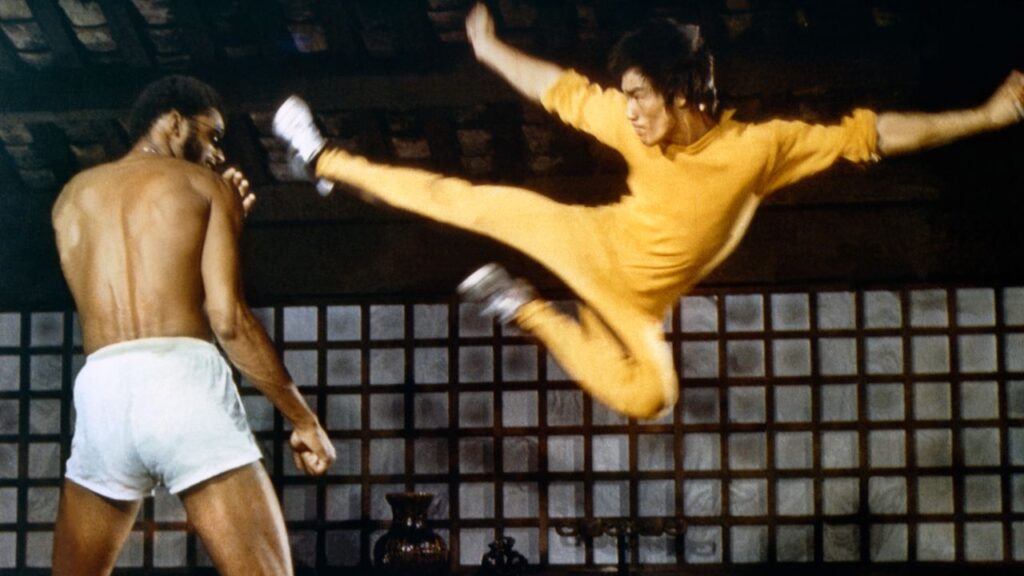Over Labor Day weekend, a couple hundred people gathered in Central Plaza, the bustling heart of Los Angeles’s Chinatown. By 10 a.m., the August sun seemed intent on making the gathering an act of endurance, but it didn’t matter—they’d gathered for the sort of spectacle most Angelenos would consider worth the sweat. The Los Angeles Lakers legend, activist, and all-around cultural titan Kareem Abdul-Jabbar would be appearing for a meet-and-greet and panel discussion to mark the release of his latest Adidas Jabbar Low colorway, which pays homage to his friendship with Bruce Lee. The sneaker, crafted from a textured yellow suede and finished with black stripes, riffs on Lee’s iconic Onitsuka Tigers and his black-and-yellow jumpsuit from the film Game of Death, in which both friends appear.
It wasn’t just height that had Lee (5’8”) and Abdul-Jabbar (7’2”) on opposite ends of the spectrum. On the surface they couldn’t have seemed more different. “We came from such diverse backgrounds,” Abdul-Jabbar told GQ in a backstage green room before his panel. Lee was a Chinese immigrant and martial artist seeking superstardom through screens large and small, but he was chasing something bigger than film credits. Lee understood that stardom was merely a conduit through which he could teach the world about the value of martial arts and his personal philosophies that stemmed from them. He also knew that his success would pave the way for Asian immigrants across America and combat the discrimination and racial bias so many of them faced. Abdul-Jabbar, meanwhile, was a generational basketball talent at center, his gifts taking him across the country from his home of New York to Los Angeles as a UCLA student. He practiced Islam, wrote for left-wing journals and newspapers, and immersed himself in the world of activism, all while pounding the paint like few other figures in the history of hoops can claim. “I think people want to know how two guys like that could have met,” he said, “How an athlete got involved in [martial arts] and with someone like Bruce, an actor.”
Abdul-Jabbar first got in touch with Lee in 1967. After studying aikido in New York, Abdul-Jabbar sought to expand his grasp of the martial arts and was interested in learning Lee’s signature discipline of Jeet Kune-Do. As the legend goes, neither man was aware of the other’s work when they met—this was prior to Lee’s movie stardom, and Abdul-Jabbar had never seen The Green Hornet. Lee didn’t keep up with American sports. As martial artists, they were opposites. Lee had all the speed, finesse, and technique that Abdul-Jabbar didn’t, though the hooper made up for it in range and power. As they trained a friendship bloomed, beginning with trips to movie theaters to catch the latest martial arts flicks. They continued training throughout the basketball season and into Abdul-Jabbar’s NBA career, the young player seeking to put on more muscle to hold up against dudes like Wilt Chamberlain. He also noticed elements of the martial arts training translated well to the court, namely in improved balance. A few years into their friendship, Lee asked Abdul-Jabbar if he’d shoot a scene for his upcoming film Game of Death. Casting his friend as the villainous heavy Hakim the Mantis, the two squared off in what became one of the most iconic fight scenes in all of martial arts cinema.
Abdul-Jabbar has never tired of talking about his late friend in the years since his untimely passing in 1973. During our conversation, he spoke of what he considers the greatest lesson that he—famously hotheaded in his days as a basketball superstar—took from the relationship. “Circumstances should not change who you are,” he explained. “There’s an arrogance that can emerge from sudden success. Some people, that really messes their heads up. And sometimes it’s for good.” He paused before continuing, “At the very end, he was still who he was.” I ask if he remembers their last conversation. “We’d finished the film,” he recalled. “He was already home, but he made sure he came to the hotel, put me in the car, and that we could say our goodbyes. That was him. He was going to be there in person.”
Lee was 32 years old when he passed away. Abdul-Jabbar was younger at 25 and has often said that his friend’s death was the first time he’d experienced that sort of significant loss in his lifetime. He takes the responsibility of shepherding his friend’s memory seriously, sharing countless stories with the crowd during his panel of Lee’s daughter Shannon riding around on his back at their family home and of his young son Brandon (of The Crow fame) being steamed that he couldn’t beat Abdul-Jabbar in a fight. “Brandon wanted to beat me up,” he said, laughing. “I had to disavow him of that thought.”


